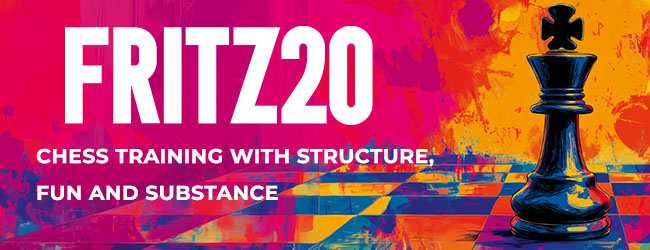Game six: ideas and refutations
With contributions by Prof. Nagesh Havanur
After five games the score was level (2½-2½). But it was Bobby who had seized the initiative and held the psychological edge on and off the board. His ceaseless demands before the world championship had created enormous tension for Boris Spassky.
To add to his worries there was uncertainty whether the match itself was going to take place or not. How does one prepare for a match when the opponent does not even deign to turn up for the opening ceremony? In fairness to Bobby, he did make an apology to Spassky, but soon he was was back to his usual self, as the enfant terrible! His brinkmanship, forfeiting the second game and throwing tantrums during the third, destroyed Spassky’s mental equilibrium altogether.
To add to his woes, Boris was under tremendous pressure from the Soviet authorities to quit rather than submit to Fischer’s ever changing demands. Spassky: “A few days before the third game I spoke for half an hour on the telephone with Pavlov [Sergei Pavlov, Sports Minister of the USSR], who demanded that I issue an ultimatum that neither Fischer, nor the organisers, nor even the FIDE President, Max Euwe, could accept. That would have ended the match. So our whole conversation consisted of an unending exchange of two phrases: 'Boris Vasileyvich, you must issue the ultimatum!' - 'Sergey Pavlovich, I am going to play the match!' After this conversation I lay in bed for three hours. I was shaking. I saved Fischer, by playing the third game. In essence I signed the capitulation of the whole match.”
Decades later he summed up his dilemma, "There was only one way I could have won that match: before the third game, when Bobby began complaining, I could have refused to play on and forfeited the game. I thought of doing this, but I was the chess king and I could not go back on my word. I had promised to play this game. As a result I ruined my fighting mood..."”
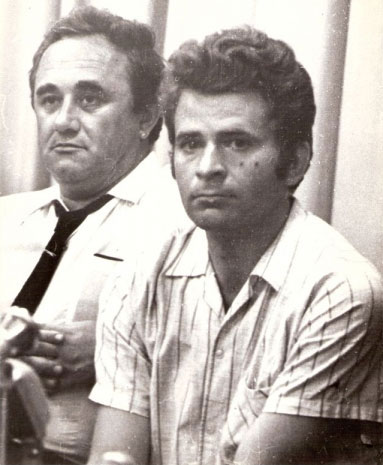 The fourth game, a tense draw, failed to restore his spirits. Efim Geller [left, here and in our title image] was Spassky’s friend and faithful second. He had prepared a line to bust the Sozin Attack that Fischer played all his life. When the position appeared on the board Boris took 45 minutes, deviated from the line they had worked on, and allowed Bobby to escape with a draw. For Geller it was particularly galling. His rivalry with Bobby went back to the 1960s, and Bobby had last beaten him in the Interzonal 1970. Then came the fifth game that broke his back. Spassky could have reveled in a sharp tactical duel, but instead was outplayed in a long maneuvering battle, and put out of his misery in the end by a blunder.
The fourth game, a tense draw, failed to restore his spirits. Efim Geller [left, here and in our title image] was Spassky’s friend and faithful second. He had prepared a line to bust the Sozin Attack that Fischer played all his life. When the position appeared on the board Boris took 45 minutes, deviated from the line they had worked on, and allowed Bobby to escape with a draw. For Geller it was particularly galling. His rivalry with Bobby went back to the 1960s, and Bobby had last beaten him in the Interzonal 1970. Then came the fifth game that broke his back. Spassky could have reveled in a sharp tactical duel, but instead was outplayed in a long maneuvering battle, and put out of his misery in the end by a blunder.
Shadow wars
The sixth game saw the World Champion still groggy and reeling from shock after all the body blows that he had received. But what about Bobby? He could hardly play 1.e4 without running into another Sicilian mine field prepared by Geller & co. So he launched a Plan B, opening with 1.c4. That shouldn’t have been a surprise to Spassky and Geller. Bobby had played the English Opening against Polugaevsky at the 1970 Interzonal, his opponent securing a draw only after some unease with his position. Bobby repeated the same opening in the last round against Oscar Panno, who protested the change in tournament timings and forfeited his game.
All this should have put the Russians on guard. It didn’t. In the ensuing Candidates Matches with Taimanov, Larsen and Petrosian Fischer had opened only with 1.e4. So the possibility of Bobby moving anything other than the king pawn was not considered as seriously, as it should have been. Only Geller was worried as he wanted Spassky to be prepared for any eventuality. However, Boris remained complacent. Whenever his seconds asked him: “What if Bobby plays 1.d4?” he would give the same lazy answer, “I shall just play the Makogonov-Bondarevsky System. What can he get from it?” Geller for one knew how wrong he was and showed him the following game:
| Replay and check the LiveBook here |
Please, wait...
1.d4 d5 2.c4 e6 3.Nc3 Be7 4.Nf3 Nf6 5.Bg5 h6 6.Bh4 0-0 7.e3 b6 8.cxd5 Nxd5 9.Bxe7 Qxe7 10.Nxd5 exd5 11.Rc1 Be6 12.Qa4 c5 13.Qa3 Rc8 14.Bb5!?N 14.Be2 14...a6? 15.dxc5 bxc5 15...Rxc5?! 16.0-0 16.0-0 Ra7 16...Qb7 17.Ba4! Qb6 18.Ne5 17.Be2 a5 17...Nd7 18.Rc3 Nd7 19.Rfc1 Re8? 19...Bg4 20.h3 20.Bb5!± Bg4 21.Nd2? 21.Rxc5! Nxc5 22.Bxe8 Bxf3 23.Qxc5 Qg5 24.g3 Ra8 25.Bb5± 21...d4! 22.exd4 cxd4 23.Qxe7 Rxe7 24.Rc8+ Kh7 25.Nb3 Ne5 26.Rd8 Rac7? 26...d3! 27.Bxd3+ 27.Rcc8 a4 28.Nd4 Reb7 27...Nxd3 28.Rxd3 Be6= 27.Rxc7 Rxc7 28.f4 Bd7 28...Nc6? 29.Rd6 Ne7 30.Nxd4 29.fxe5? 29.Bxd7! Nxd7 30.Nxa5± 29...Bxb5 30.Nxd4 30.Rxd4? a4! 31.Nd2 Rc1+ 32.Kf2 Rc2 33.Ke3 Rxb2 30...Rc1+? 30...Rc5! 31.Kf2 Rd1 32.Rd6 1–0
- Start an analysis engine:
- Try maximizing the board:
- Use the four cursor keys to replay the game. Make moves to analyse yourself.
- Press Ctrl-B to rotate the board.
- Drag the split bars between window panes.
- Download&Clip PGN/GIF/FEN/QR Codes. Share the game.
- Games viewed here will automatically be stored in your cloud clipboard (if you are logged in). Use the cloud clipboard also in ChessBase.
- Create an account to access the games cloud.
| Furman,S | - | Geller,E | - | 1–0 | 1970 | D59 | Moscow | |
Please, wait...
A curious game marred by mutual errors in the end! Yet Geller was sufficiently disturbed by the collapse of his favourite defence to Queen’s Gambit. A connoisseur of opening theory, he annotated his loss in the Chess Informant offering an improvement for Black that eventually turned out to be insufficient.
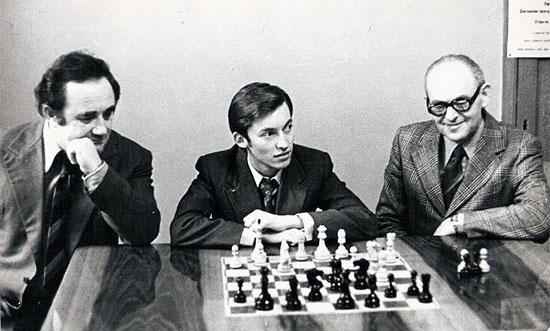
Geller and Furman, with with the young Anatoly Karpov, for whom Furman was a mentor.
Across the ocean, thousands of miles away, there sat an American grandmaster looking at the same game on his pocket chess board and his eyes lit up. That was Bobby. He had found a way of beating Boris! But how did he know Boris would play the line? The answer lay in the Red Book, the Spassky Bible that he devoured day and night.

In the 1950s, Dr. Edward Wildhagen announced an ambitions project entitled “Weltgeschichte des Schachs” which means “World History of Chess”. His plan was to include every game ever played by great masters with a diagram every five moves, so that one could play over the games without setting up the board and pieces. There were 16 volumes published in this series, each dedicated to one great player. In the book Bobby found twelve games played by Spassky, none of which he lost, but there were no wins either: it was part of his drawing arsenal. The Furman-Geller game gave Bobby an idea on how to draw Boris out of his protective shell.
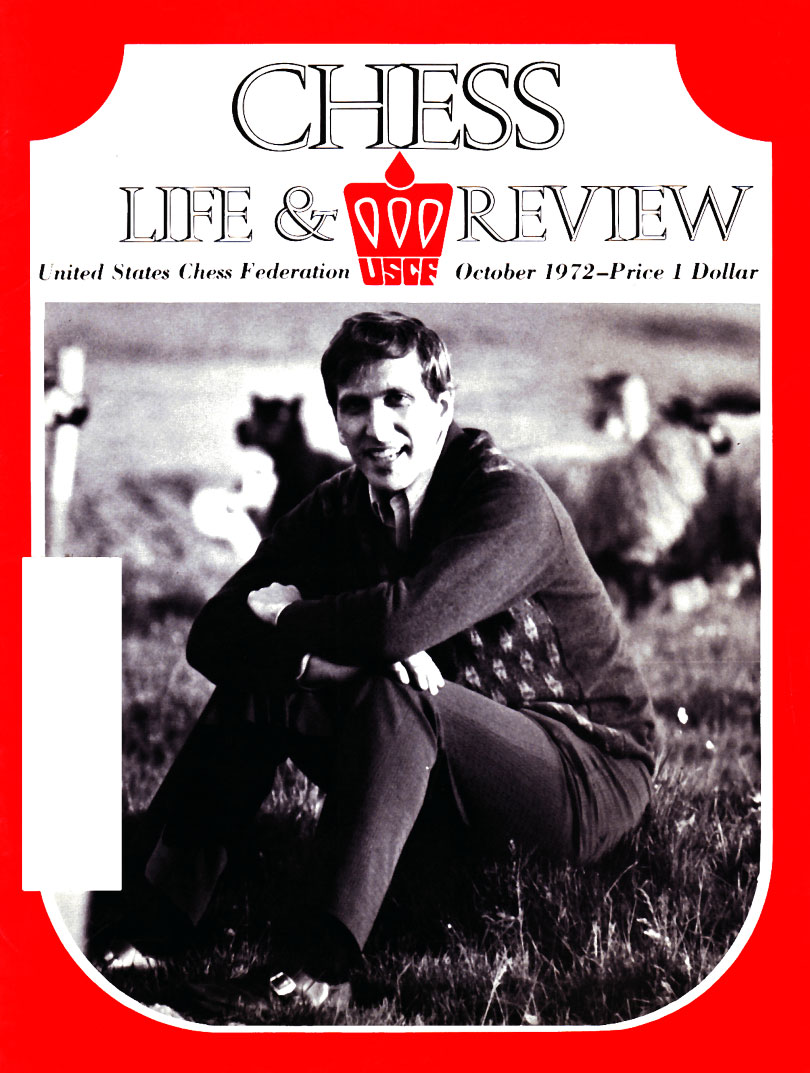
What followed in Game Six of the Match is eloquently described in a report by GM Robert Byrne in Chess Life & Review, October 1972, pages 607-609 (the pages of CL&R were numbered through for the entire year, at that time):
Just as he did in the second week of play, Bobby dominated the third week's contests, racking up 2½ points out of three for a 2-point lead in the match. Some are saying that Boris is playing badly. It isn't true—he's not getting a chance to play at all. Fischer pounces on him so sharply, usually right in the opening, that he is unable to show what he can do. How can a marvelous attacking player reveal his stuff when he cannot get a position that permits him to fire even one salvo?
The biggest blow to Spassky's self-assurance was game six. For the first time in his life, Bobby played the Queen's Gambit, having always maintained that it was "dull and a draw." And he beat Spassky, who had never lost a game with his favorite Tartakower Variation! The bare facts are no dazzling they need no embellishment. Just play over the game.

Fischer and Spassky in Reykjavik [photo Skáksamband Íslands – Icelandic Chess Federation]
| Replay and check the LiveBook here |
Please, wait...
1.c4 e6 2.Nf3 d5 3.d4 Nf6 4.Nc3 Be7 5.Bg5 0-0 6.e3 h6 7.Bh4 b6 8.cxd5 Nxd5 9.Bxe7 Qxe7 10.Nxd5 exd5 11.Rc1 Be6 12.Qa4 c5 13.Qa3 Rc8 14.Bb5! a6 15.dxc5 bxc5 16.0-0 Ra7 16...Qb7 17.Be2 Nd7 18.Nd4 Qf8 18...Nf8 19.Nxe6 fxe6 20.e4! d4 20...dxe4 21.Bc4 Qe7 22.Rfe1 Nf6 23.f3 Kh8 24.fxe4 e5 25.Rcd1 21.f4 Qe7 21...e5 22.fxe5 Qe7 23.e6 22.e5 Rb8 23.Bc4 Kh8 23...Nb6? 24.Qb3 24.Qh3 Nf8 24...Rxb2 25.Bxe6 25.b3 a5 26.f5 exf5 27.Rxf5 Nh7 28.Rcf1 28.Rf7 Ng5 28...Qd8 29.Qg3 Re7 30.h4 Rbb7 31.e6 Rbc7 31...Qc7 32.Rf8+ 32.Qe5 Qe8 33.a4 Qd8 34.R1f2 Qe8 35.R2f3 Qd8 36.Bd3 Qe8 37.Qe4 Nf6 37...Rxe6? 38.Rf8+ Nxf8 39.Rxf8+ Qxf8 40.Qh7# 38.Rxf6! gxf6 39.Rxf6 Kg8 40.Bc4 Kh8 41.Qf4 41.Qf4 Rc8 41...Kg8 42.Qxh6 -- 43.Rg6+ 42.Rxh6+ Kg8 43.Qg4+ Rg7 44.e7+ Qf7 45.Qxc8# 1–0
- Start an analysis engine:
- Try maximizing the board:
- Use the four cursor keys to replay the game. Make moves to analyse yourself.
- Press Ctrl-B to rotate the board.
- Drag the split bars between window panes.
- Download&Clip PGN/GIF/FEN/QR Codes. Share the game.
- Games viewed here will automatically be stored in your cloud clipboard (if you are logged in). Use the cloud clipboard also in ChessBase.
- Create an account to access the games cloud.
| Fischer,R | 2785 | Spassky,B | 2660 | 1–0 | 1972 | D59 | Reykjavik World Championship Game 6 | 6 |
Please, wait...
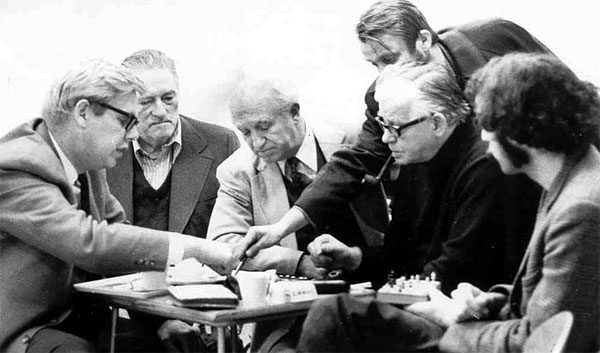
Game six was a classic that Miguel Najdorf, above in the middle, during the match in Reykjavik, likened to a symphony by Mozart! The sixth game has been annotated by a number of contemporaries like Samuel Reshevsky, Reuben Fine, Svetozar Gligoric, C.H.O’D Alexander and others.

Around the same time young Jan Timman [above in a 1968 picture by Chess Diagonals] made an independent investigation of the whole game, and his example was emulated by Yasser Seirawan and Graham Burgess who also provided a useful correction to previous analysis. The last word on it all was by Garry Kasparov. ChessBase offers an update:
| Replay and check the LiveBook here |
Please, wait...
1.c4 e6 2.Nf3 d5 3.d4 Nf6 4.Nc3 Be7 5.Bg5 0-0 6.e3 h6 7.Bh4 b6 8.cxd5 Nxd5 9.Bxe7 Qxe7 10.Nxd5 exd5 11.Rc1 Be6 12.Qa4 c5 13.Qa3 Rc8 14.Bb5!? 14.Be2 14...a6? 14...Nd7 15.Bxd7 Bxd7 16.dxc5 bxc5 17.0-0 14...Qb7! 15.dxc5 bxc5 16.Rxc5 Rxc5 17.Qxc5 Na6! 15.dxc5 bxc5 15...Rxc5 16.0-0 16.0-0 Ra7? 16...Qb7 17.Ba4 c4 18.Nd4 Qb6 19.Rfd1 Nd7 20.Nxe6 Qxe6 21.e4± 16...Nc6 17.Bxc6 Rxc6 18.Ne5 Rc7 19.Rfd1 16...Qa7 17.Be2 17.Ba4? a5! 17...Nd7 18.Rfd1 17.Be2 Nd7 17...a5 18.Rc3 Nd7 19.Rfc1 Re8 20.Bb5 18.Nd4! Qf8? 18...Nf6! 19.Nb3 Rac7!∞ 19...c4 20.Qxe7 Rxe7 21.Nd4 a5= 19.Nxe6 fxe6 20.e4! 20...d4? 20...c4 21.Qh3 Rc6! 21...Nc5?! 22.b4 cxb3 23.axb3 22.b3 Nb6 23.Rfd1 21.f4 Qe7 22.e5 Rb8?! 22...Nb6 23.Qd3! 23.f5 c4 23...Nd5 24.Qe4 Qf7 25.f5 Ne3 26.fxe6 Qxe6 27.Bd3 Rf7 28.Qh7+ Kf8 29.Rxf7+ Qxf7 30.Bc4! Nxc4 31.Rf1+- 23.Bc4 Kh8 23...Nb6? 24.Qb3! 24.Qh3 Nf8 24...Rxb2 25.Bxe6 Rab7 26.Rce1± 25.b3 a5 26.f5 exf5 27.Rxf5 Nh7 27...Ng6? 28.Qg3! 28.Rf7? Qg5! 28...Qe8 29.Rcf1 27...Ne6? 28.Bxe6 Qxe6 29.Rf8++- 28.Rcf1 28.Rf7? Ng5 29.Rxe7 Nxh3+ 30.gxh3 Rxe7-+ 28...Qd8 28...Rf8? 29.Rxf8+ Nxf8 30.Qc8+- 29.Qg3 Re7 30.h4! 30.Rf7? Rxf7 31.Rxf7 Qg5 30...Rbb7 31.e6 Rbc7 32.Qe5 Qe8 33.a4 Qd8 34.R1f2 Qe8 34...d3? 35.Rd2+- 35.R2f3 Qd8 36.Bd3 Qe8 36...Qg8 37.Rf7 Rxf7 38.exf7 Rxf7 39.Bc4+- 37.Qe4! Nf6 37...Rxe6?? 38.Rf8+! Nxf8 39.Rxf8+ Qxf8 40.Qh7# 38.Rxf6!+- gxf6 39.Rxf6 Kg8 40.Bc4 Kh8 41.Qf4 1–0 - Start an analysis engine:
- Try maximizing the board:
- Use the four cursor keys to replay the game. Make moves to analyse yourself.
- Press Ctrl-B to rotate the board.
- Drag the split bars between window panes.
- Download&Clip PGN/GIF/FEN/QR Codes. Share the game.
- Games viewed here will automatically be stored in your cloud clipboard (if you are logged in). Use the cloud clipboard also in ChessBase.
- Create an account to access the games cloud.
| Fischer,R | 2785 | Spassky,B | 2660 | 1–0 | 1972 | D59 | Reykjavik World Championship Game 6 | |
Please, wait...
Move times
Here are the times for game six, as recorded by Lawrence Stevens, who visited the match in Reykjavik and jotted them down from the video screens:
|
Game 6, July 23rd, 1972
Fischer Spassky
White Black
1. c4 (0:08) e6 (0:02)
2. Nf3 (0:11) d5 (0:03)
3. d4 (0:11) Nf6 (0:03)
4. Nc3 (0:11) Be7 (0:03)
5. Bg5 (0:11) 0-0 (0:04)
6. e3 (0:12) h6 (0:04)
7. Bh4 (0:13) b6 (0:08)
8. cxd5 (0:13) Nxd5 (0:08)
9. Bxe7 (0:14) Qxe7 (0:08)
10. Nxd5 (0:14) exd5 (0:08)
11. Rc1 (0:14) Be6 (0:09) |
12. Qa4 (0:14) c5 (0:12)
13. Qa3 (0:14) Rc8 (0:16)
14. Bb5 (0:15) a6 (0:19)
15. dxc5 (0:19) bxc5 (0:23)
16. 0-0 (0:20) Ra7 (0:36)
17. Be2 (0:23) Nd7 (0:52)
18. Nd4 (0:28) Qf8 (1:11)
19. Nxe6 (0:39) fxe6 (1:11)
20. e4 (0:42) d4 (1:13)
21. f4 (0:47) Qe7 (1:19)
22. e5 (0:51) Rb8 (1:23)
23. Bc4 (1:02) Kh8 (1:33)
24. Qh3 (1:03) Nf8 (1:36)
25. b3 (1:08) a5 (1:36)
26. f5 (1:12) exf5 (1:38)
27. Rxf5 (1:12) Nh7 (1:42)
|
28. Rcf1 (1:15) Qd8 (1:48)
29. Qg3 (1:20) Re7 (1:54)
30. h4 (1:28) Rbb7 (1:57)
31. e6 (1:38) Rbc7 (1:59)
32. Qe5 (1:47) Qe8 (2:05)
33. a4 (1:48) Qd8 (2:12)
34. R1f2 (1:53) Qe8 (2:12)
35. R2f3 (1:53) Qd8 (2:12)
36. Bd3 (1:57) Qe8 (2:16)
37. Qe4 (1:58) Nf6 (2:18)
38. Rxf6 (1:58) gxf6 (2:18)
39. Rxf6 (1:58) Kg8 (2:25)
40. Bc4 (1:59) Kh8 (2:28)
41. Qf4 (2:04) 1-0 |
“Mines always explode” – Efim Geller
This game had an unintended aftermath. When Boris returned despondent after the game, Geller asked him why he had not played 14…Qb7 that could have refuted the entire concept of 14.Bb5!? After all he had analysed the whole variation with Boris during their preparation for the match. The world champion had not cared to remember and in any case it was the last line he was prepared to see on that fateful day. A year later Jan Timman tried the same thing against Geller, and the mine that had been set for Fischer exploded. Here is the game:
| Replay and check the LiveBook here |
Please, wait...
1.d4 d5 2.c4 e6 3.Nc3 Be7 4.Nf3 Nf6 5.Bg5 0-0 6.e3 h6 7.Bh4 b6 8.cxd5 Nxd5 9.Bxe7 Qxe7 10.Nxd5 exd5 11.Rc1 Be6 12.Qa4 c5 13.Qa3 Rc8 14.Bb5!? 14.Be2 14...Qb7!N 14...a6? 15.dxc5 bxc5 16.0-0 Ra7 17.Be2 15.dxc5 bxc5 16.Rxc5 Rxc5 17.Qxc5 17...Na6! 18.Bxa6 18.Qc6? Qxc6 19.Bxc6 Rb8! 20.b3 20.0-0 Rxb2 20...Rc8 18...Qxa6 19.Qa3 Qc4 20.Kd2? 20.Qc3 Rb8! 20...Qxa2? 21.0-0 21.Qxc4 dxc4 22.b3 cxb3 23.axb3 Rxb3 24.0-0 Rb2 20...Qg4 21.Rg1 d4! 22.Nxd4 22.exd4 Rb8 22...Qh4 23.Re1 Qxf2+ 24.Re2 Qf1 25.Nxe6 fxe6 26.Qd6 Kh8 27.e4 Rc8 28.Ke3 Rf8 29.Rd2 29.Kd2 e5! 29...e5!-+ 30.Qxe5 Qe1+ 31.Re2 Qg1+ 32.Kd3 Rd8+ 33.Kc3 Qd1 34.Qb5 Qd4+ 35.Kc2 a6 36.Qxa6 Qc5+ 0–1 - Start an analysis engine:
- Try maximizing the board:
- Use the four cursor keys to replay the game. Make moves to analyse yourself.
- Press Ctrl-B to rotate the board.
- Drag the split bars between window panes.
- Download&Clip PGN/GIF/FEN/QR Codes. Share the game.
- Games viewed here will automatically be stored in your cloud clipboard (if you are logged in). Use the cloud clipboard also in ChessBase.
- Create an account to access the games cloud.
| Timman,J | 2480 | Geller,E | 2590 | 0–1 | 1973 | D59 | Hilversum | |
Please, wait...
It’s a pity that Spassky did not benefit from Geller’s discovery. As for Bobby, he wisely refrained from repeating Furman’s novelty during the rest of the match.
Opening theory has advanced a lot since 1972, but if you want to learn how to play the Queens Gambit, you can do it from one of the best possible authorities: Garry Kasparov:
Garry Kasparov took to the Queen’s Gambit at a relatively late stage of his chess career, but then had the best training anyone could imagine: in his first match for the world championship against Anatoly Karpov, this opening appeared on the board no less than 19 times. Now he shares his knowledge with you.
Game seven
Robert Byrne in Reykjavik wrote:
"It may have looked as though Boris has something going for him in the 7th game, but it was all sophisticated teasing on Fischer's part. He marched confidently through the complex labyrinth of his prepared analysis, which allowed Boris assorted potshots to prevent Black from castling, but nothing else of more than ephemeral value. Soon Boris found himself in full retreat, a pawn down and with a lost game. Had Fischer not fallen prey to overconfidence, he would have won easily for a total shutout week, instead of giving up a half point."
Here is the game, with comments by Robert Byrne in Chess Life and Review, October 1972, pp. 608-609.
| Replay and check the LiveBook here |
Please, wait...
1.e4 c5 2.Nf3 d6 3.d4 cxd4 4.Nxd4 Nf6 5.Nc3 a6 6.Bg5 e6 7.f4 Qb6 8.Qd2 Qxb2 9.Nb3 Qa3 10.Bd3 10.Bxf6 gxf6 11.Be2 10...Be7 11.0-0 h6! 12.Bh4 Nxe4! 13.Nxe4 Bxh4 14.f5 14.Nxd6+? Qxd6 15.Bb5+ Ke7 14...exf5 15.Bb5+ axb5 16.Nxd6+ 16...Kf8 16...Ke7 17.Qe3+ Kxd6 17...Kf6 18.Nxf5! Bxf5 19.Rxf5+ Kxf5 20.Rf1+ Kg6 21.Qe4+ Kh5 22.g4+ Kg5 23.Qf5# 18.Rad1+ Kc7 19.Qe5+ Kb6 20.Qd4+ 17.Nxc8 Nc6 18.Nd6 18.Qd7 g6 19.Nd6 19.Qxb7 Qa6 19...Be7 20.Nxb5 20.Nxf5 Qa7+ 21.Nfd4 21.Kh1 Rd8 22.Qc7 gxf5 21...Nxd4 22.Qxd4 Qxd4+ 23.Nxd4 Bc5 20...Qa6 21.Qd3 18...Rd8 19.Nxb5 Qe7 19...Rxd2 20.Nxa3 Rd5 21.Nc4 g6 22.Rad1 Rxd1 23.Rxd1 Ke7 24.Nc5 20.Qf4 g6 21.a4 Bg5 22.Qc4 Be3+ 23.Kh1 f4 24.g3 g5 25.Rae1 Qb4 26.Qxb4+ Nxb4 27.Re2 Kg7 27...Nc6 28.Na5 b6 29.Nc4 Nd5 30.Ncd6 Bc5? 30...Kg6 31.Nxf7? Kxf7 32.c4 Kg6 33.cxd5 Rxd5 31.Nb7 Rc8 32.c4 Ne3 33.Rf3 Nxc4 34.gxf4 g4 35.Rd3 h5 36.h3 Na5 37.N7d6 Bxd6 38.Nxd6 Rc1+ 39.Kg2 Nc4 40.Ne8+ Kg6 41.h4! 41...f6 42.Re6 Rc2+ 43.Kg1 Kf5 43...Kf7 44.f5 Rxe8 45.Rd7+ Kf8 46.Rxf6+ 44.Ng7+ Kxf4 45.Rd4+ Kg3 46.Nf5+ Kf3 47.Ree4 Rc1+ 48.Kh2 Rc2+ 49.Kg1 ½–½ - Start an analysis engine:
- Try maximizing the board:
- Use the four cursor keys to replay the game. Make moves to analyse yourself.
- Press Ctrl-B to rotate the board.
- Drag the split bars between window panes.
- Download&Clip PGN/GIF/FEN/QR Codes. Share the game.
- Games viewed here will automatically be stored in your cloud clipboard (if you are logged in). Use the cloud clipboard also in ChessBase.
- Create an account to access the games cloud.
| Spassky,B | 2660 | Fischer,R | 2785 | ½–½ | 1972 | B97 | Reykjavik World Championship (7) | 7 |
Please, wait...
So this was the stand in the Match of the Century after game seven, which was completed on July 26, 1972, exactly forty-five years ago.

– To be continued –
Previous articles
Bobby Fischer in Iceland – 45 years ago (1)
In the final week of June 1972 the chess world was in turmoil. The match between World Champion Boris Spassky and his challenger Bobby Fischer was scheduled to begin, in the Icelandic capital of Reykjavik, on July 1st. But there was no sign of Fischer. The opening ceremony took place without him, and the first game, scheduled for July 2nd, was postponed. Then finally, in the early hours of July 4th, Fischer arrived. Frederic Friedel narrates.
Bobby Fischer in Iceland – 45 years ago (2)
The legendary Match of the Century between Boris Spassky and Bobby Fischer was staged in the Laugardalshöllin in Reykjavik. This is Iceland’s largest sporting arena, seating 5,500, but also the site for concerts – Led Zeppelin, Leonard Cohen and David Bowie all played there. 45 years after the Spassky-Fischer spectacle Frederic Friedel visited Laugardalshöllin and discovered some treasures there.
Bobby Fischer in Iceland – 45 years ago (3)
On July 11, 1992 the legendary Match of the Century between Boris Spassky and Bobby Fischer finally began. Fischer arrived late, due to heavy traffic. To everybody's surprise he played a Nimzo instead of his normal Gruenfeld or King's Indian. The game developed along uninspired lines and most experts were predicting a draw. And then, on move twenty-nine, Fischer engaged in one of the most dangerous gambles of his career. "One move, and we hit every front page in the world!" said a blissful organiser.
Bobby Fischer in Iceland – 45 years ago (4)
7/16/2017 – The challenger, tormented by the cameras installed in the playing hall, traumatically lost the first game of his match against World Champion Boris Spassky. He continued his vigorous protest, and when his demands were not met Fischer did not turn up for game two. He was forfeited and the score was 0-2. Bobby booked a flight back to New York, but practically at the very last moment decided to play game three – in an isolated ping-pong room!
Bobby Fischer in Iceland – 45 years ago (5)
7/21/2017 – After three games in the Match of the Century the score was 2:1 for the reigning World Champion. In game four Spassky played a well-prepared Sicilian and obtained a raging attack. Fischer defended tenaciously and the game was drawn. Then came a key game, about which the 1972 US Champion and New York Times and Chess Life correspondent GM Robert Byrne filed reports. In Reykjavik chess fan Lawrence Stevens from California did something extraordinary: he manually recorded the times both players had spent on each move.
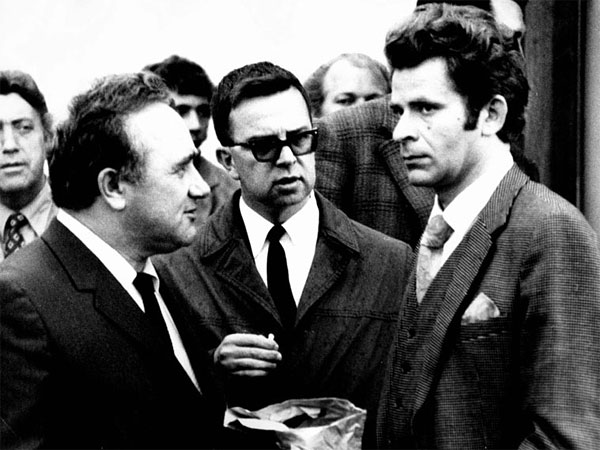

















 The fourth game
The fourth game






